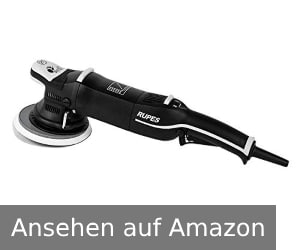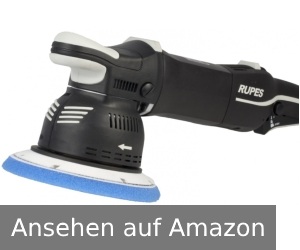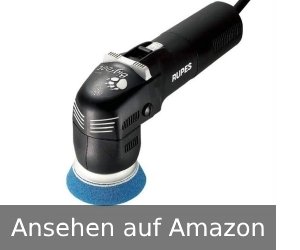Die italienische Firma Rupes gibt es bereits seit dem Jahr 1947. Seitdem hat sich die kleine Firma zu einem der führenden Poliermaschinen Hersteller entwickelt.
Mit ihren Rupes Poliermaschinen aus der BigFoot Reihe begeistern sie nicht nur professionelle Anwender, auch immer mehr Hobby Aufbereiter träumen von einer Rupes Poliermaschine.
Um dir einen Überblick über die vielen Modelle zu verschaffen, stellen wir dir in diesem Artikel die beliebtesten Modelle vor und klären dich über die Unterschiede auf. So findest auch du die perfekte Rupes Poliermaschine für deinen Einsatzzweck.
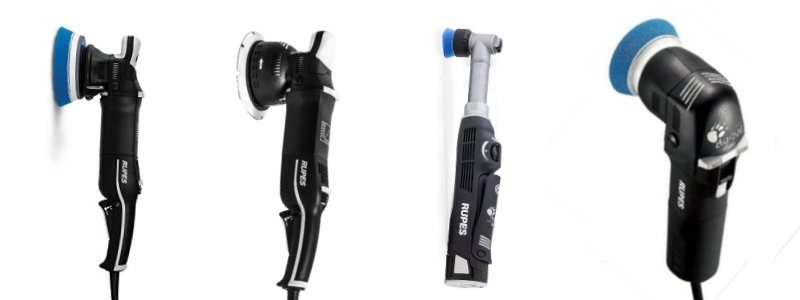
Rupes BigFoot Poliermaschinen


Von professionellen Autoaufbereitern geliebt. Rupes hat spätestens mit der Entwicklung der Mark II Big Foot den Exzenter Poliermaschinen Markt im Sturm erobert.
Schließlich wurden die ohnehin schon guten Poliermaschinen in der 2. Version nochmals verbessert.
Im Jahre 2019 wurde dann diese bereits überarbeitete Version nochmal verbessert. Die neuste Version hört auf den Namen Mark 3 und erinnert daher etwas an die Anzüge von Iron Man, welche auch stetig verbessert werden und in jeder Version über neue Features verfügen.
Die Neuerungen der verbesserten Rupes Poliermaschine
Auch bei der neusten Version dieser Rupes Poliermaschine sind tolle Features und Verbesserungen eingeflossen und haben so eine tolle Poliermaschine weiter perfektioniert.
Der offensichtlichste Unterschied ist der jetzt vollständig gummierte Griff. Bei der Vorgängerversion war hier auf der Oberseite noch Kunststoff im Carbonlook verbaut. Gerade mit schwitzigen Händen hatte man hier hin und wieder Probleme mit dem richtigen Griff.
Neben einem größeren Einstellrad für die Drehzahl, welches leichter ablesbar ist, verfügt die neue Rupes BigFoot Poliermaschine nun auch über einen progressiven Gasgebeschalter. Das bedeutet man kann trotz eingestellter Drehzahlstufe 6 die Maschine auch langsam laufen lassen, indem man den Gasgebeschalter nicht vollständig durchdrückt. Wie wir finden eine tolle Neuerung.
Neben einem etwas abgeänderten Design wurde natürlich auch unter der Haube etwas verbessert. Zwar hat der Motor auf dem Papier immer noch 500 Watt aber die Leistung der Poliermaschine hat sich trotzdem verbessert. Auch das Drehzahldiagramm ist jetzt über alle Stufen hinweg vollkommen linear, was das Arbeiten sehr angenehm macht.
Technische Eigenschaften
Ein Hub von 15mm macht die Poliermaschine in Verbindung mit dem 125mm Stützteller sehr flexibel einsetzbar. Die Drehzahl ist von 3.000-5.200 min-1 variabel steuerbar.
Die Drehzahlregulierung erfolgt elektronisch über einen Wahlrad mit 6 Stufen. Die Regelung erfolgt dabei elektronisch, was zu einer erhöhten Effizienz führt. Deshalb genügt der Rupes bereits eine Leistungsaufnahme von 500 Watt um die gleiche oder sogar bessere Leistung zu erzielen wie viele auf dem Papier deutlich stärkere Maschinen.
Mit nur 2,6kg ist die Rupes Bigfoot LHR 15 Mark 3 für ihre Größe sehr leicht.
Zusammenfassend ist dies wohl die perfekte Rupes Poliermaschine für jeden der eine Allround Maschine sucht und bereit ist etwas mehr Geld in die Hand zu nehmen. Wer nur große Flächen zu bearbeiten hat, kann zur LHR 21 greifen. Für alle anderen empfehlen wir die LHR 15.
Die Mark III beinhaltet viele der neuen Funktionen, die erstmals auf der LK900E Mille gezeigt wurden, und interessante Design-Updates, die eines der besten Poliersysteme der Branche noch besser machen.




Vorteile |
|---|
Höchste Qualität |
Vibrationsarm |
Effizienter Motor |
Perfekte Ergonomie |
Ideal für die meisten Flächen am Fahrzeug |
Sanftanlauf |
Geschwindigkeit auch über Gasgebeschalter regelbar |
9 Meter Kabellänge |
Nachteile |
|---|
Sehr hoher Preis |
Weißer Gummi verschmutzt leicht |
Die Rupes Mille ist eine vollkommene Neuentwicklung. Sie ersetzt nicht etwa die bisherigen Modelle von Rupes, sondern ergänzt die Modellpalette am oberen Ende.
Mit nur 5 mm Hub hat die Mille einen sehr geringen Hub im vergleich mit den anderen Rupes Poliermaschinen. Meist haben diese einen Hub von 12-21 mm.
Dafür verfügt die Rupes Mille LK900E aber über einen Zwangsantrieb. Dadurch schließt sie die Lücke zwischen einer Rotations- und einer Exzenter Poliermaschine. Sie vereint die hohe Abtragsleistung einer Rotationspoliermaschine mit dem mühelosem Finnish einer Exzenter Poliermaschine.
Man muss also keine Angst vor Überhitzung des Lackes und Hologrammen haben, erreicht aber trotzdem eine hohe Defektkorrektur.
Durch den Zwangsantrieb bleibt die Maschine nie stehen, egal wie viel Druck man ausübt. Gerade die ersten Rupes Modelle hatten gerne mal Aussetzer bei zu viel Druck.
Vorteile |
|---|
9 Meter Kabel |
900 Watt Leistung |
Zwangsantrieb |
Hohe Defektkorrektur |
Vibrationsarm |
Nachteile |
|---|
Hoher Preis |
Zwangsantrieb nicht abschaltbar wie z.B. bei Makita |
Weißer Gummi verschmutzt leicht |
Ein weiteres Modell aus der BigFoot Reihe ist die Rupes LHR75. Eine Exzenter Poliermaschine für alle stellen an denen man mit den anderen Maschinen mit einem Stützteller von 125 mm oder mehr im wahrsten Sinne des Wortes an die Grenzen stößt.
Wie der Name vielleicht schon verrät verfügt diese Rupes Poliermaschine über einen 75 mm großen Polierteller. Somit ist sie bestens geeignet für Stoßstangen, Spoiler und andere schwer zugängliche Stellen.
Mit einem Gewicht von nur 2,3 kg ist die Maschine außerdem ein echtes Leichtgewicht. Der Exzenterhub von 12 mm passt sehr gut zum Einsatzzweck der Poliermaschine. Der Hub ist groß genug um eine gute Abtragsleistung zu erzielen aber nicht zu groß um das Handling zu verschlechtern.
Mit 400 Watt hat diese Rupes Poliermaschine 100 Watt weniger Leistung als die meisten ihrer Kollegen aus der BigFoot Baureihe. Trotzdem verfügt man in jeder Polierlage über genügend Leistungsreserven um auch tiefere Defekte effektiv bearbeiten zu können.
Vorteile |
|---|
Ideal für enge Stellen |
Leichtgewicht |
12 mm Hub |
Sanftanlauf |
Geringes Gewicht |
Nachteile |
|---|
Preis |
Griff nicht gummiert |
Für Stellen die selbst für die Rupes LHR75 zu eng sind hat Rupes natürlich auch eine Poliermaschine im Angebot.
Ohne Zweifel handel es sich bei der Rupes iBrid Nano um die beste Poliermaschine für Detailarbeiten.
Im Gegensatz zu den anderen Rupes Poliermaschinen verfügt dieses Modell über einen Akku und kann somit auch ohne lästiges Kabel eingesetzt werden.
Aber auch der Betrieb mit angeschlossenem Kabel ist möglich, sollte der Akku einmal noch nicht voll geladen sein. Diese Flexibilität ist uns ein extra Lob wert.
Unserer Meinung nach darf die Rupes iBrid in keinem Maschinenpark eines professionellen Autoaufbereiters fehlen. Aber auch Hobbyanwender die nicht vor der zugegebenermaßen hohen Investition zurückschrecken werden mit der Rupes iBrid Nano glücklich.
Hier die Daten und Fakten der Rupes iBird:
- Drehzahl regelbar zwischen 2000 und 5000 min-1
- 30 und 50 mm großer Stützteller
- Hub zwischen 3 und 12 mm wählbar oder Rotationsbetrieb
- Soft-Start
- LED Anzeige
Vorteile |
|---|
Elektrisch oder mit Akku einsetzbar |
Hohe Qualität |
Perfekt für Detailarbeiten |
Großer Drehzahlbereich |
Nachteile |
|---|
Sehr hoher Preis |
Spezieller Einsatzbereich |
Rupes Polierpads
Mit 5 Polierpads jeden Härtegrades ist man sehr gut ausgestattet. Und dank der perfekt auf die Rupes Poliermaschinen abgestimmten Rupes Polierpads ist ein sehr gutes Ergebnis fast schon garantiert
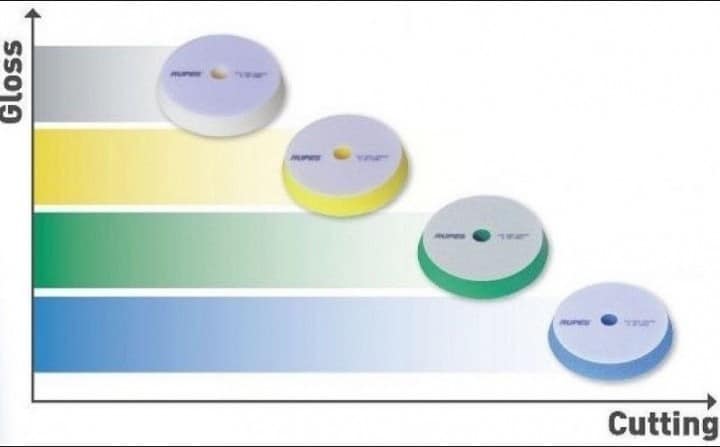
Rupes Politur
COARSE
Für die erste Stufe der Politur. Das aggressive Korn schafft eine schnelle Bearbeitung und entfernt auch tiefere Kratzer.
MEDIUM
Die perfekte Polierpaste zum Entfernen leichter Kratzer (z.B. Waschstraßenkratzer).
FINE
Die ideale Politur um einen hohen Glanzgrad, speziell bei anspruchsvollen harten Lacken zu erreichen.
ULTRAFINE
Verbessert den Glanzgrad und die Farbtiefe der Oberfläche. Ideal um Hologramme zu entfernen.
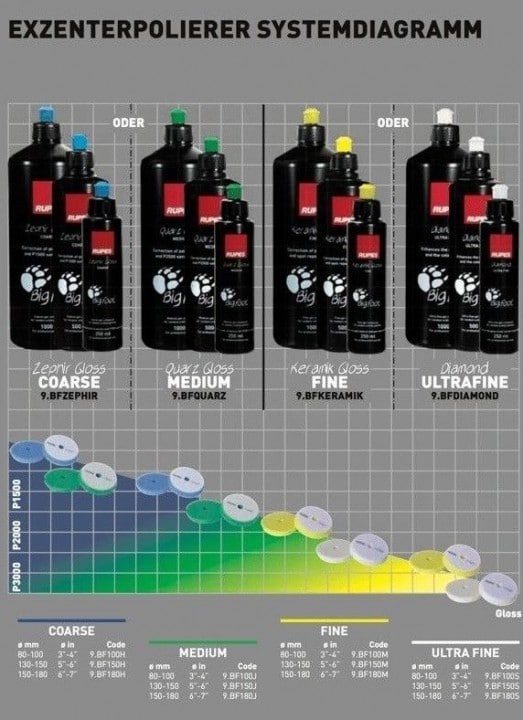
Verwandte Poliermaschinen Artikel:
